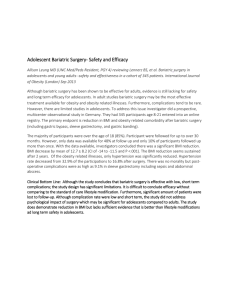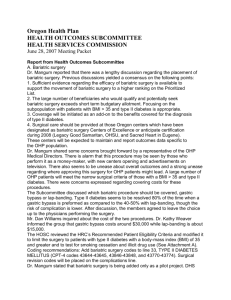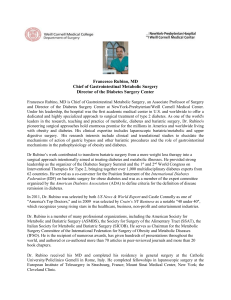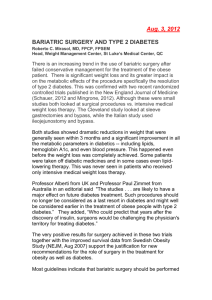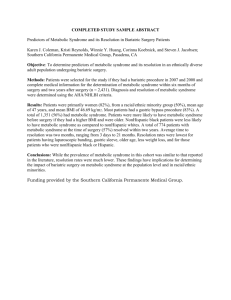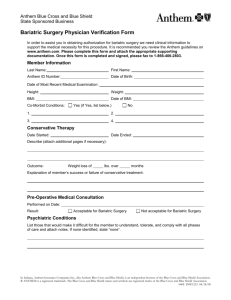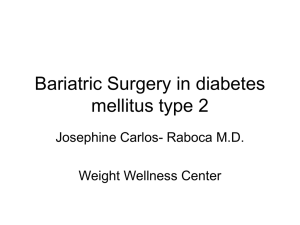METABOLIC SURGERY
advertisement
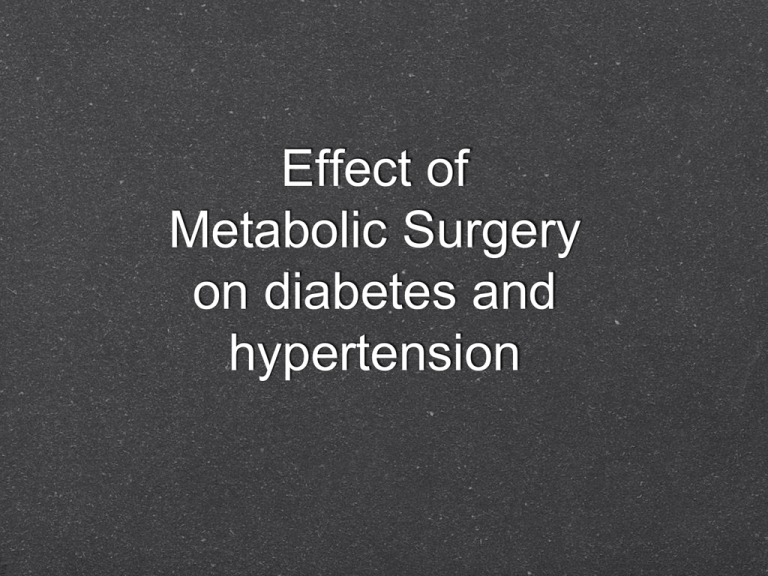
Effect of Metabolic Surgery on diabetes and hypertension Objectives brief overview of Bariatric surgery management of bariatric surgery patients and complications effects of bariatric surgery on diabetes Metabolic Syndrome Central obesity. (defined as waist circumference ≥ 40 inches for men and ≥ 35cm for women) raised TG level: ≥ 150 mg/dL reduced HDL cholesterol: < 40 mg/dL raised blood pressure: systolic BP ≥ 130 or diastolic BP ≥ 85 mm Hg, or treatment of previously diagnosed hypertension raised fasting plasma glucose (FPG) ≥ 100 mg/dL or previously diagnosed type 2 diabetes Metabolic Syndrome 54 Million Americans! A quarter of the world’s adults have metabolic syndrome twice as likely to die from, and three times as likely to have a MI or CVA a five-fold greater risk of developing type 2 diabetes The Metabolic Syndrome: A Network of Atherogenic Factors Type 2 diabetes and glycemic disorders Free Fatty Acids Hypertension Impaired thrombolysis - PAI-1 Endothelial dysfunction/ inflammation - CRP, MMP-9 Microalbuminuria 5 | Atherosclerosis Visceral Obesity Insulin Resistance Dyslipidemia - Low HDL - Small, dense LDL particles - Hypertriglyceridemia Medical Sequelae of Obesity Hypertension Lipid disorders Diabetes Ischaemic heart disease Cardiomyopathy Pulmonary hypertension Asthma Obstructive sleep apnea Gallstones NASH (Non-alcoholic steatohepatitis) Urinary incontinence GERD Arthritis/back pain Infertility/menstrual problems Obstetric complications DVT and thromboembolism Depression Immobility Breast/bowel/prostate/endometrial cancer Venous stasis ulcers Intertrigo Accident prone Body Mass Index BMI > 25: Over weight, 2/3rd US BMI > 30: Obese, 1/3rd US BMI > 40: Morbid Obese, 6% US Americans) (18 million Criteria BMI > 40 BMI > 35 plus 1 or 2 co-morbidities T2D , Hypertension OSA, NASH Hyperlipidemia, Pseudo tumor cerebri Considerably impaired quality of life • Bariatric surgery or weight-loss surgery refers to surgery usually performed in patients with a body mass index (BMI) of 40 kg/m2 or greater and those with a BMI between 35 and 40 kg/m2 and a major medical comorbidity in order to: • • • Support weight loss Treat or prevent obesity-related comorbidities (e.g., diabetes, hypertension, cardiovascular disease, obstructive sleep apnea) The most common types of bariatric surgery include: • Laparoscopic adjustable gastric banding (LAGB) • Roux-en-Y gastric bypass (RYGB) • Sleeve gastrectomy • Biliopancreatic diversion with duodenal switch (BPD/DS) • • • Studies show that bariatric surgery causes significant weight loss and is more effective at improving diabetes in the short term (up to 2 years) than nonsurgical interventions (diet, exercise, other behavioral interventions, and medications). Diabetes improvement starts rapidly after surgery, before significant weight loss has occurred. The mechanism for postoperative metabolic improvements has not been fully elucidated and may be, in part, independent of weight loss. • This suggests that bariatric surgery may improve metabolic comorbidities even in patients who are not morbidly obese. The Adipo-insular Axis Free fatty acids and insulin resistance – Theories Impaired insulin signaling (muscle) / glucose transport Increased oxidative stress (reactive oxygen species) Inhibition of insulin suppression of glycogenolysis in liver Direct endothelial damage Impairment of beta cell function Alterations in blood pressure Outcomes Non-Surgical management: only 5-10% success T2D remission: up to 72% at 2 years RYGB sustained remission of 62% at 6 years All-cause mortality reduced by 40% 7 years after RYGB Cause specific mortality reduction: T2D 92%, Cancer 60%, CAD 56% Pre-op work up Cardiology, Pulmonary, Psychiatry Home sleep study Blood test Clinical nutrition evaluation smoking cessation Pregnancy counseling Thank you
